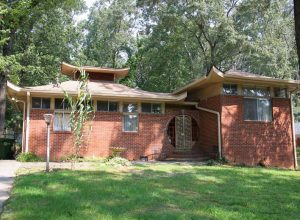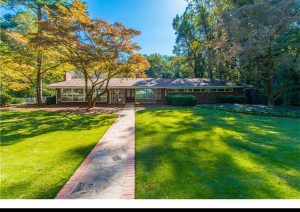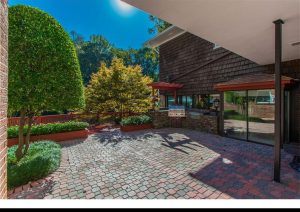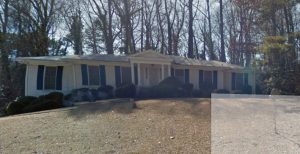Collier Heights Historic District

Basement in Collier Heights remodeled 2017 by HausZwei Homes and Kevin Polite.
Across the country and especially across the South, there are many other important mid-201″-century African-American suburban developments, some right in Atlanta, seemingly similar to Collier Heights. On the surface, many of them are-they provided new housing in a suburban setting for an emerging family-oriented black middle class. But behind the scenes, there are fundamental differences. Many
mid-20th century “African-American” suburbs were created for blacks but planned largely by white
real estate interests, built by white developers, and funded by white-owned financial institutions; sales may have been handled by black agents, houses may have been constructed by black builders, and of course the homebuyers were black. Some examples include the older Washington Heights Park
in Charlotte, North Carolina (developed by a white developer but sold through black real estate agents), the newer McCrorey Heights also in Charlotte (made famous in Sam Fullwood Ill’s 1997 book, Waking from the Dream), Richmond Heights in Miami (built by a white developer), Pontchartrain Park in New Orleans with its precedent-setting African-American golf course (developed by a white developer and built by a white contractor), Ronak Park on Long Island (built by a “co/or-blind” white developer for African Americans and other ethnic homebuyers excluded from the nearby Levittown), and the expansive Hamilton Park in Dallas, Texas, (a true planned suburb with supporting commercial, educational, religious, and recreational facilities, contemporary with Collier Heights but planned and developed largely by local white real estate leaders and political figures and financed by white banks). Many smaller or less diverse suburbs built for and by African Americans are known to exist; some are located in Atlanta, on the west side of the city, predating Collier Heights (Fountain Place, Chicamauga Heights, or Fair Haven, for example), and others, in other communities, have already been listed ln the National Register (for example, Edwards Heights in Oklahoma City and Burnett Avenue near St. Louis) or are being considered for National Register nomination (for example, Hanford Village in Columbus, Ohio). Another important African-American suburb just recently “rediscovered” is Berkley Square in Las Vegas, Nevada, with its 1950s development funded at least partly by the nationally prominent civil rights activist Thomas L Berkley of Oakland, California, and its modest ranch houses designed by the noted California African* American architect Paul Williams. Most of these historically significant smaller developments were intended for a narrower or more specific market, and many would be more accurately described as “subdivisions” rather than “suburbs.” To date, no other African-American suburbs approximating the size, scope, variety, and quality of Collier Heights built for and by African Americans have been identified. To Buy or sell a home in Collier Heights or Cascade call Kevin Polite, Solid Source Realty, 404-299-7100. HausZwei Homes To search homes are read a monthly report of sales in the area go to HausZwei Homes
Description of present and historic physical appearance:
SUMMARY DESCRIPTION
The following summary description is provided by the Historic Preservation Division, Georgia Department of Natural Resources.
The Collier Heights Historic District is a mid-20th-century residential suburb six miles west of downtown Atlanta consisting of 1,700 houses in 54 small interrelated subdivisions on approximately 1,000 acres of land developed between 1941 and 1979. A few earlier rural houses are located along several roads on the periphery of the area. The district is located northeast of the Interstate 20/285 interchange and is roughly bounded by Hamilton E. Holmes Drive (formerly Hightower Road) on the east, Donald Lee Hollowell Parkway (formerly Bankhead Highway) on the north, Interstate 285 on the west, and Interstate 20 on the south. The street layout is irregular, reflecting incremental development Hightower Road) on the east edge of the district. Mid-century suburban development occurred from Hamilton E. Holmes Drive westward and from 1-285 eastward. The majority of houses are mid-20th century Ranch Houses, along with a smaller number of Split-Levels and a very few two-story houses; also included 20th-century Craftsman Bungalows and some mid-century American Small Houses. Virtually every size and type of Ranch House is represented, from small and compact to large and rambling, and from the simple linear to courtyard and other complex forms. Architectural styles include Colonial Revival and Contemporary with a few examples of Modern. Many house designs appear to be from period plan books such as those published in Atlanta by the Home Builders Plan Service and W. D. Farmer; others are custom designs. Most of the houses are wood framed with brick veneer; many have a combination of brick, stone, and wood exteriors. Roofs are mostly gabled or hipped; a few houses have flat roofs. Windows are of varied types and sizes and include a wide range of picture windows. Many of the houses feature large chimneys; most have integral carports or garages. Landscaping is informal with open lawns, large pine and hardwood trees often surrounded by pine-straw beds, and ornamental shrubbery; plantings around foundations and front terraced entries or rear patios are common. Streets are curvilinear in layout; most have concrete curbs, with a few in the older sections having granite curbstones. There are no sidewalks. One small park is nestled within one of the subdivisions; another large park is located at the southwest periphery of the district. Community landmark buildings are located on the edges of the district and include several churches and schools. The churches feature varied architectural styles including Colonial Revival and Modern; the school buildings are designed in the Modern or International Style, with one example of the mid-century style known as Brutalism. Only about five percent of the properties in the district are non-contributing; most are later houses.
To Buy or sell a home in Collier Heights or Cascade call Kevin Polite, Solid Source Realty, 404-299-7100. www.hauszweihomes.com
Collier Heights Historic District. Atlanta, Fulton County, Georgia

Collier Heights Mid Century Modern
DETAILED CURRENT AND HISTORICAL DESCRIPTIONS
The, following detailed description is taken from the “Historic District Information Form: Collier Heights,” dated April 12, 2008, prepared by graduate students in the Georgia State University heritage preservation program on behalf of the Collier Heights Neighborhood Association, on file at the Historic Preservation Division, Georgia
Department of Natural Resources (see Section 9, “Major Bibliographical References,”
for the full citation including participating students’ names). Minor editing has been done by the Historic Preservation Division.
General Description of the District
The mid-20th century was a time of intense change and expansion for the Atlanta area. After the Second World War, population growth, housing shortages, urban renewal, and the construction of Interstate highways pushed Atlanta’s boundaries outward. While this movement from the city to the suburbs was largely the privilege of white residents, there were significant instances of suburbanization on the part of the city’s African-American population which had been hardest hit by housing shortages, overcrowding, and poor conditions in residential area. While many African American suburbanization opportunities in Atlanta at this time were the result of “white flight” or transitioning, which transformed many previously all-white neighborhoods into majority-black areas seemingly overnight, Collier Heights is unique. This mid-century neighborhood, located in an area of west Atlanta not annexed into the city limits until 1952, is the quintessential example of upper- and middle-class suburbanization in Atlanta during the mid-20th century with one significant distinction: it was developed as the result of an African-American initiative, and it specifically served an African American population.
While the main body of Collier Heights was developed for African Americans, there was development in the area prior to 1951 that consisted of early 20th Century -bungalows and mid-century American Small Houses and modest Ranch Houses originally built for white homeowners. This small-scale
development was located west of Hamilton E. Holmes Drive (then Hightower Road). This early
development was quickly vacated by whites once African Americans began building and moving into the area after 1954.
When African Americans began purchasing lots in Collier Heights, the area undergoing black residential development encompassed a vast stretch of land roughly bounded by Hamilton H. Holmes Drive (then Hightower Road) on the east, Donald Lee Hollowell Parkway (then the Bankhead Highway) on the north, what is now Fulton Industrial Boulevard on the west, and Martin Luther King Jr. Drive (then Gordon Road) to the south. Starting in the mid-1950s, this up-and-coming large area was touted in the city’s leading African-American newspaper, the Atlanta Daily World, as the most prominent African-American residential area in Atlanta. The construction of Interstate Highways 20 (east-west) and 285 (north-south) starting in the late 1950s, and their intersection in the Collier Heights area, divided the area into four quadrants separated by the interstate highways. While residential development continued throughout the area, three of these quadrants eventually became known by other names. The area encompassed by this historic district, in the northeast quadrant of the Interstate highway interchange, bounded roughly by 1-20, 1-285, Donald Lee Hollowell Parkway (then the Bankhead Highway), and Hamilton E. Holmes Drive (then Hightower Road), continued to be referred to as Collier Heights. It is the largest, oldest, and most intact portion of the original “Collier Heights” suburb, and it contains the greatest range and diversity of mid-century houses. By way of a patchwork quilt-like development pattern of approximately 54 independent subdivisions, the neighborhood currently known as Collier Heights was created.
Collier Heights Historic District, Atlanta, Fulton County, Georgia as rewritten by Kevin Polite, HausZwei Homes, www.hauszweihomes.com. To Buy or sell a home in Collier Heights or Cascade call Kevin Polite, Solid Source Realty, 404-299-7100. www.hauszweihomes.com
Developed and built were the Ranch and Split-Level houses that characterize the area today. Large house lots integrated with the natural topography, curvilinear streets and cui-de-sacs, and ample. Vegetation characterized the neighborhood. Churches and schools were built along the borders of the neighborhood where they helped to create and maintain a sense of community in the newly developed neighborhood.
By the early 1960s, the Collier Heights neighborhood was being celebrated in nationally known publications including The New York Times and Time magazine as the premier residential enclave of African Americans in the southeastern United States. Some of Atlanta’s most prominent African American figures, including Ralph D. Abernathy, Herman Russell, Martin Luther King, Sr., and Asa Yancey, Sr., had made Collier Heights their home, where they not only remained as residents but also worked hard to protect the area from commercial development and higher-density multi-family developments as single-family residential development slowed during the late 1970s.
Today, Collier Heights remains unique in that, despite radical changes in development along its boundaries and general changing tastes in residential development, it retains not only a remarkable degree of architectural and developmental integrity but also a notable population of original and long term residents.
The Collier Heights district includes a large area of residential development, a small peripheral area of community buildings, and some green space. Acreage wise,
Family residential development.
The large residential development area is cohesive and not infiltrated by other types of development, aside from designated park land and schools. This area of Collier Heights includes three primary distinguishable types of residential development. The oldest of these, early 20′”-century rural development, is characterized by a few Bungalow-type houses. It is followed chronologically by a few small subdivisions of American Small Houses. The most recent and most significant development consists of mid-20th-century houses including primarily Ranch and Split-Level houses. Bungalows
Are scattered throughout on relatively large lots fronting the north and middle portions of the east boundary of the neighborhood, Hamilton E. Holmes Drive (formerly Hightower Road), an early
Collier Heights Historic District, Atlanta, Fulton County, Georgia as rewritten by Kevin Polite, HausZwei Homes, www.hauszweihomes.com. To Buy or sell a home in Collier Heights or Cascade call Kevin Polite, Solid Source Realty, 404-299-7100. www.hauszweihomes.com

HJ Russell Collier Heights mid century ranch Atlanta
c
I
Collier Heights Historic District, Atlanta, Fulton County, Georgia as rewritten by Kevin Polite, HausZwei Homes.com 7 To Buy or sell a home in Collier Heights or Cascade call Kevin Polite, Solid Source Realty, 404-299-7100. www.hauszweihomes.com
I

Collier Heights Historic District ranch house Atlanta

Collier Heights Historic District Ranch Atlanta
T
1955: First subdivisions developed by and for African Americans.
To Buy or sell a home in Collier Heights or Cascade call Kevin Polite, Solid Source Realty, 404-299-7100. www.hauszweihomes.com
« Back to Home Page


